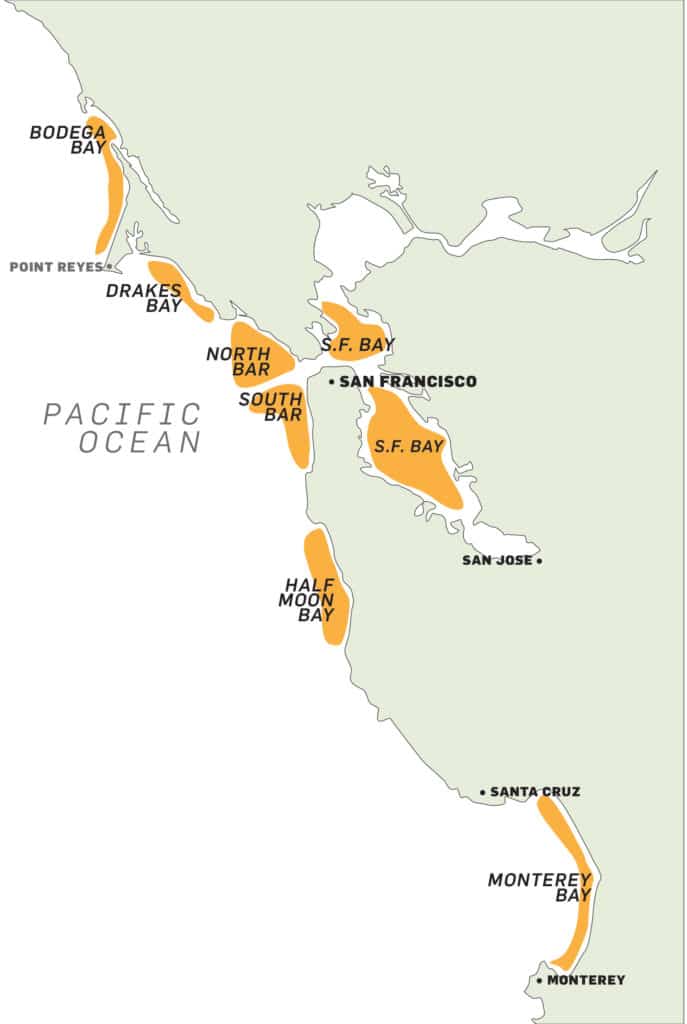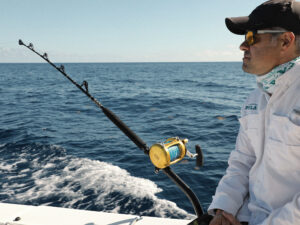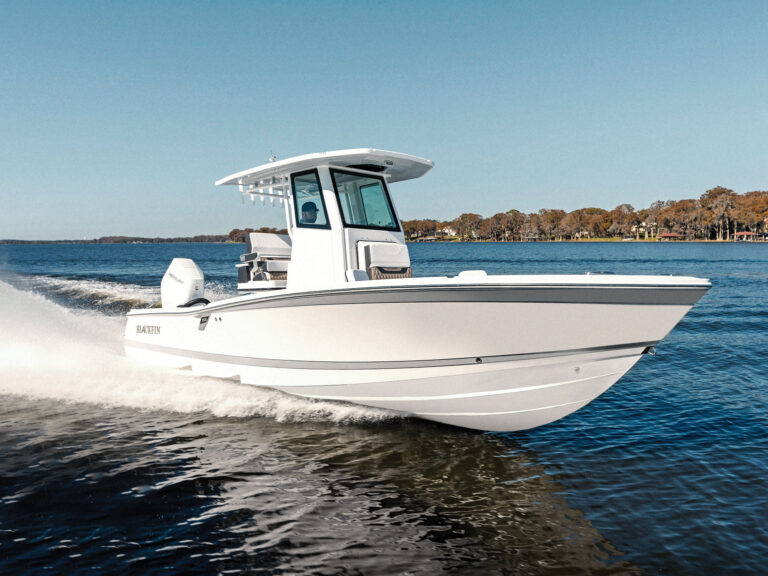
Everything is just right. Set up with four weighted lines rigged with live bait, I follow the edge of an outgoing tide using a stop-and-go method known as “motor mooching.” The audible whoosh from surfacing humpback whales as they form a feeding circle catches our attention. To our east, the famed San Francisco Cliff House and the glint of commuter traffic keep things in perspective. Erring on the side of caution, we maintain a safe distance from the whales.
Without warning, two rods on the starboard side load up. It’s every man for himself as my brother, Angelo, and I jump on the rods. Luckily the lines stay tight, and we eventually scoop two husky 25-pound California halibut. Once the bite goes off, the action comes quickly. As soon as we get the lines back in, we get another double with fish nearly equal in size to the first two. A hundred pounds of fish in the boat means a lot of tasty fillets for friends and family.

Halibut are Picky Eaters
The summer and fall, when bait floods the coastal zones, are some of the best times to catch trophy California halibut, but these hefty fish can be a challenge. Feeding on a rich menu of baitfish and squid, these bottom-hugging couch potatoes prefer to pick and nibble just enough to satisfy their appetites. That’s when motor mooching comes into play, a stop-and-go technique to hop the bait across the bottom, simulating wounded prey. Like dangling a carrot in front of a horse, a big halibut just finds this hard to resist.
Where to Find California Halibut
California halibut prefer sandy open bars from 30 to over 60 feet in depth, but they also hunker down near rocky points, coves and islands where they can ambush unsuspecting prey. The sandy beaches from Bodega Bay, Half Moon Bay and Santa Cruz south to Monterey Bay offer unlimited opportunities, and boaters can access prime spots from local harbors. In many cases, it’s a short run to reach productive zones.

Two of my favorite areas include the North Bar off the Marin coastline and the South Bar outside San Francisco. Both offer huge stretches to work, and they consistently attract big flatties during summer and fall.
Motor mooching produces on both incoming and outgoing tides, but weak-to-moderate tides are often best. And generally halibut prefer to bite either when the current starts to speed up or when it begins slowing down. Motor mooching also allows you to cover the area faster and more efficiently, especially when the tide is slow.
Live Bait for Halibut

What’s on the halibut’s menu varies, but I favor bigger anchovies or sardines when available. However, when they’re not, jacksmelt in the 8- to 12-inch range can be equally good.
You can catch jacksmelt on the bay flats or along points and coves. Anchor up and chum with mashed-up anchovies. The moment the anchovy slick starts boiling off the stern, you can catch the jacksmelt on sabikis or small spoons. Once my livewell has 15 to 20 baits, it’s time to go.
Halibut spread out on both the North and South bars. You’ll need to cover lots of water, but targeting subtle bottom changes, particularly where the depth rises or falls, narrows the search. Bait schools in the same area boost your odds of success. Also, watch for tidal edges, which are especially prominent during the first push of an outgoing tide and appear as ruffled edges as the water runs out. On the North Bar, the outgoing edge pushes west, while at the South Bar, it travels southwest. Halibut scatter along the length of these tidal edges. So when fishing a defined edge, I tack along its entire length.
Fishing for Halibut

When using multiple lines, once you’ve determined the current speed and depth, rig the close lines with heavier sinkers and go lighter on the long rods. This keeps your spread staggered, and the added baits simulate a school. When rigging a sardine or jacksmelt, I push the hook point through the tip of the lower jaw until it appears through the top of the bait’s upper jaw.
Normally tach speed is slow at about 1.5 knots. I put the engine in gear and drop down enough line so the sinkers consistently tick along the bottom. The moment I see the line angle plane up slightly, I shift back to neutral. When the sinker drops and ticks bottom, as indicated by the bouncing rod tip, I pop the engine back into gear. Again, the moment the line begins to plane up, I go back to neutral. This stop-and-start tempo causes the bait to hop along the bottom.
For more effective coverage, I cross the current or point the bow into the current, and I set the reels with the clickers on to signal strikes. If I get a short strike, I slowly angle down-current and then come back up-current through the same area. Always check your bait. If it gets mauled, change to a fresh one. When you get a strike, mark it on the GPS. Summer halibut aggregate in specific areas. After the first hookup takes place, stay on that spot and pound it. More action is bound to quickly follow. For those prone to seasickness, especially when the ocean swell jumps up, motor mooching works just as well inside San Francisco Bay.
Northern California Halibut Fishing Tackle
- Rods: 7- to 8-foot Cousins 270, 1196 or equivalent
- Reels: Conventional, rated for 30- to 50-pound braid
- Leader: 30- to40-pound-test fluorocarbon
- Sinkers: Cannonball sinkers, 8 to 18 ounces, on sliding sinker sleeves
- Hooks: 1/0 to 3/0 Owner SSW hooks, and ST-41 No. 4 and No. 2 trebles
- Live Bait: Bait can be purchased at Fisherman’s Wharf in San Francisco or Berkeley Marina in the East Bay.

- Halibut Habitat: Start your search for fish over nearshore bars and shoals in depths ranging from 30 to 60 feet.
- Bounce Bottom: Take into consideration depth, boat speed, and weight to keep baits on the bottom within the strike zone.
- Location, Location: Generally, where you find one halibut you’ll find more, so work productive spots thoroughly.









